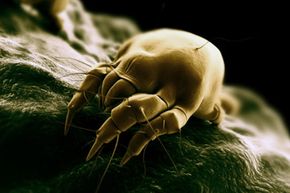Are you one of the estimated 50 million Americans who suffer from allergies? More than half of all Americans have an allergic response to at least one substance, and more than half of American homes have six (or more) common, detectable allergens [source: American Academy of Allergy Asthma & Immunology]. Along with animal dander, dust, mildew and mold spores, dust mites are one of the most common triggers of indoor allergies and asthma. Indoor allergies are usually caused by small particles that we inhale, and because dust mites are microscopic, you'll find them even in the cleanest of homes. They like to eat the dead skin cells that flake off of us as we go about our day -- we shed about 0.05 ounce (1.5 grams) of skin every day, which will feed about one million hungry dust mites [source: Asthma and Allergy Foundation of America].
So where does this huge mite population live? They live, eat, breed and die in our sofas, chairs, carpeting, curtains, bedding and mattresses. Mites have a short life span, and in just 3 weeks, a new generation of dust mites will inhabit all your stuff.
Advertisement
Unlike bedbugs, dust mites don't bite -- it's the protein in their waste products (decaying dust mites as well as dust mite fecal matter) that can trigger an allergic response in an estimated 18 to 30 percent of Americans [source: Johannes]. While keeping them at bay may seem impossible, there are ways to minimize your exposure.
Let's look at the bedroom, since it's where we spend most of our time. If you sleep eight hours each night, that's about 3,000 hours a year in bed. Keeping your mattress free from dust mites is key to waking up feeling refreshed rather than sneezy and tired. Encasing your mattress and pillows in allergen-proof covers, and washing and drying all bedding on your appliances' hottest settings -- the water needs to be at least 130 degrees F to kill dust mites -- every week is one of the best ways to reduce allergens in your bed.
Vacuuming your mattress, however, may not do as much to relieve a dust mite problem as you may hope. As it turns out, mites are hearty -- not only can they survive a trip through the wash if the water isn't hot enough, they can also survive your attempts at vacuuming them up. As many as 95 percent of dust mites continue to lead their lives after you've tried to vacuum them from your mattress [source: Asthma and Allergy Foundation of America]. How can this be? Because they don't live on the surface; rather, they live deep within the stuffing of the mattress.
While vacuuming your mattress isn't very effective in reducing mattress allergens, people who suffer from allergies should try using HEPA (high-efficiency particulate) filters when vacuuming carpets, curtains and other items that are mite-friendly but not stuffed.
Check out the next page to learn more about fighting dust mite allergies.
Advertisement


